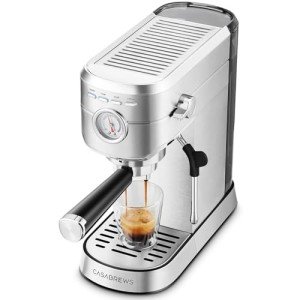Heat Exchange Espresso Machines: A Comprehensive Guide
Espresso machines have progressed significantly over the years, dealing with the needs of home baristas and coffee specialists alike. Among these machines, heat exchange espresso machines have actually gained popularity due to their ability to deliver constant performance and extraordinary brew quality. In this short article, we will explore the operations, advantages, and crucial features of heat exchange espresso machines, supplying an extensive understanding for both possible purchasers and coffee lovers.
Understanding Heat Exchange Technology
Heat exchange espresso machines operate on a distinct concept that enables synchronised water heating for brewing and steaming. They are geared up with a single boiler that makes use of a heat exchanger system. This feature is significant as it enables users to brew espresso while steaming milk concurrently, promoting effectiveness in the coffee-making procedure.
How Does a Heat Exchange Espresso Machine Work?
The process starts with the machine's water inlet filling the boiler. As Espresso Machines With Grinder warms up, it turns to steam. The innovative heat exchanger utilizes hot steam to heat additional water in a different passage created specifically for the brew group. This indicates that water can reach the ideal developing temperature level without waiting on the boiler to change. The crucial steps include:
- Water Fill: Water is drawn into the boiler.
- Heating Process: The boiler warms up as water is transformed into steam.
- Heat Exchange: Steam heats up water in the heat exchanger tube.
- Brewing: Water from the heat exchanger is pressed through coffee grounds, extracting the tastes needed for a rich espresso.
This procedure enables quick temperature level changes and improved coffee extraction.
Advantages of Heat Exchange Espresso Machines
Heat exchange espresso machines provide numerous advantages, particularly for those wanting to optimize their coffee experience. Here are some key benefits:
- Simultaneous Brewing and Steaming: Users can brew espresso while steaming milk, making it perfect for busy coffee shops and home baristas who value efficiency.
- Temperature Stability: The boiler's steam pressure helps keep a steady temperature level, which is crucial for consistent espresso extraction.
- Flexibility: The design permits fast switching in between developing and steaming, making it easier to produce numerous coffee drinks, from lattes to coffees.
- Easy to use: Models typically feature accessible controls, making it possible for both beginners and knowledgeable baristas to produce quality beverages.
- Professional Quality: Heat exchange machines are typically used in commercial settings, offering users with high-quality brewing efficiency in your home.
Key Features to Look for in Heat Exchange Espresso Machines
When considering the purchase of a heat exchange espresso machine, there are several functions that a person need to take into consideration:
- Build Quality: Look for machines made of durable products, such as stainless steel or brass, ensuring durability.
- Boiler Size: A larger boiler will hold more water and sustain higher output over time.
- PID Temperature Control: This feature assists keep consistent brew temperatures, which can improve the coffee-making process.
- Group Head Design: Machines with a saturated or semi-saturated group head offer much better temperature level stability.
- Reduce of Use: User-friendly user interfaces and instinctive controls enhance the overall experience for baristas at all skill levels.
- Steam Wand Quality: A good steam wand with correct insulation and flexibility enables better texturing of milk.
- Water Reservoir Size: Depending on your requirements, think about how often you want to fill up the water tank.
Contrast of Popular Heat Exchange Espresso Machines
To better understand the choices available in the market, listed below is a comparison table of some popular heat exchange espresso machines:
| Machine Model | Boiler Size | PID Control | Rate Range | User Ratings |
|---|---|---|---|---|
| Profitec Pro 700 | 2.0 L | Yes | ₤ 2,000-₤ 2,500 | 9.5/ 10 |
| Rocket Espresso R58 | 1.8 L | Yes | ₤ 2,400-₤ 2,800 | 9.4/ 10 |
| Elekta Bianca | 1.8 L | Yes | ₤ 2,500-₤ 3,000 | 9.6/ 10 |
| La Spaziale S1 Vivaldi II | 1.5 L | Yes | ₤ 1,800-₤ 2,200 | 9.2/ 10 |
| Bezzera Magica | 1.2 L | No | ₤ 1,600-₤ 1,800 | 9.0/ 10 |
FAQs About Heat Exchange Espresso Machines
What is the primary distinction in between a heat exchange and a dual boiler espresso machine?
While both types can brew espresso and steam milk at the same time, dual boiler machines have different boilers for brewing and steaming. On the other hand, heat exchange machines utilize a single boiler and a heat exchanger to achieve the very same function.
Are heat exchange machines ideal for newbies?
Yes! Many heat exchange machines are developed with easy to use functions, making them accessible for beginners. With Portable Espresso Machines and practice, users can quickly produce quality espresso.
What sort of upkeep do heat exchange espresso machines require?
Routine upkeep consists of descaling, cleaning up the boiler, examining seals and gaskets, and keeping the group head tidy. Regular maintenance ensures durability and consistent performance.
Can I use a heat exchange machine for various types of coffee beverages?
Definitely! Portable Espresso Machines permit users to develop a range of coffee drinks, including espresso, lattes, coffees, and more.
Heat exchange espresso machines represent a mix of development and tradition, providing coffee lovers with the tools required for crafting the ideal cup. Their capability to at the same time brew and steam, integrated with precise temperature control, makes them an engaging choice for both home baristas and specialists. With the best understanding on functions and upkeep, users can unlock a world of charming coffee experiences, guaranteeing that each sip is as delightful as the last.

